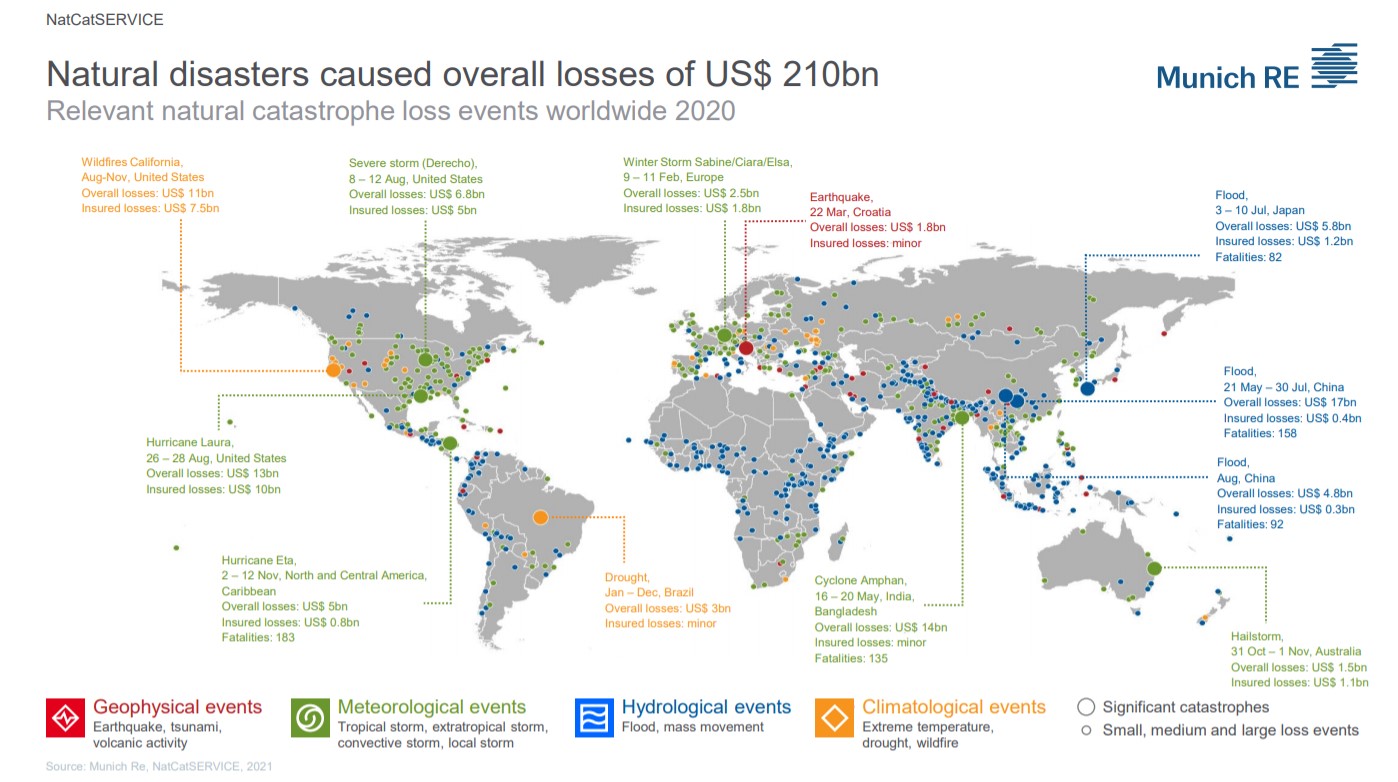Five years after the Paris Climate Agreement, 2020 continued the series of very warm years. The global mean temperature (January to November) in 2020 was around 1.2°C higher than pre-industrial levels (1880–1900) – just 0.01°C shy of 2016, the warmest year on record.
Ernst Rauch, Chief Climate and Geo Scientist at Munich Re, commented as follows: “Even if the weather disasters for one year cannot be directly linked to climate change, and a longer period needs to be studied to assess their significance, these extreme values fit with the expected consequences of a decades-long warming trend for the atmosphere and oceans that is influencing risks. An increasing number of heatwaves and droughts are fuelling wildfires, and severe tropical cyclones and thunderstorms are becoming more frequent. Research shows that events such as this year’s heatwaves in northern Siberia are 600 times more likely to occur than previously.”

Storms
Of the ten costliest natural disasters in 2020, six occurred within the United States. The most destructive event was a Category 4 hurricane, Laura, which made landfall on 27 August near Lake Charles in western Louisiana with winds of 240 km/h. Hurricane Laura caused substantial wind and storm surge damage and triggered widespread flooding that extended far inland. Overall losses came to US$ 13bn.
The hurricane season in the North Atlantic was hyperactive, with a record-setting 30 storms, 13 of which reached hurricane status. This surpassed the previous record year of 2005 (28 storms; 15 hurricanes).
One striking feature of the 2020 season was rapid intensification before landfall – a phenomenon that has been observed in several landfalling storms in recent years. Also unusual was the strength of storms that developed towards the end of the season, typically when both tropical cyclone frequency and intensity start to wind down. Seven cyclones developed in October and November, five of which became hurricanes, including Iota, which was the last and strongest hurricane of the season, developing to a Category 5 storm in November.
In the central United States, one of the year’s costliest disasters was a strong “derecho”, a fast-moving line of severe thunderstorms that swept across the US Midwest on 10 August, causing losses of US$ 6.8bn. Hardest hit was the state of Iowa, where several million hectares of corn and soybean crops were destroyed. The derecho was just one of the notable events in a highly active loss year across the country due to convective storms. Overall losses of US$ 40bn, were significantly higher than in the previous year (US$ 30bn).
Wildfires
Once again, a series of large wildfires raged across the western United States in 2020, including record-setting fires (in terms of area burned) in California and Colorado. Drought conditions, particularly across northern California and the Pacific Northwest, helped fuel dozens of large fires. 47 people lost their lives due to the fires.
It was notable that damaging wildfires occurred not just in California, but across the rest of the western US as well. Colorado saw its three largest fires, in terms of acres burned, in 2020. Wildfires in Washington and Oregon also set new records. In Oregon alone, about 4,000 homes were damaged or destroyed by wildfires, becoming one of the worst natural disasters in the state’s history. In total, losses from the wildfires in the western United States amounted to some US$ 16bn.
Asia: Serious cyclones and floods
In Asia, losses from natural disasters were lower than in the previous year, although summer floods in China represented the costliest individual event worldwide. Overall losses in Asia came to US$ 67bn (2019: US$ 77bn).
In the northern Indian Ocean, Cyclone Amphan, which made landfall on 20 May on the border between India and Bangladesh, was the year’s costliest tropical cyclone. Losses came to US$ 14bn.
In the Northwest Pacific, tropical cyclone Haishen developed into the first super typhoon of the 2020 Pacific season. It initially skirted the southwest coast of Japan, bringing heavy rainfall, storm surges, flooding and landslides. On 7 September, it made landfall on the coast of South Korea. Overall losses came to US$ 1.2bn.
In the Kyushu region of southern Japan, record rainfall at the start of July produced floods, landslides and mudslides. Dykes failed and a number of bridges were swept away. More than 80 people were killed and over a million had to evacuate the region.
In Europe, the natural disaster figures for 2020 were relatively benign. Overall losses came to US$ 12bn (€10.6bn).